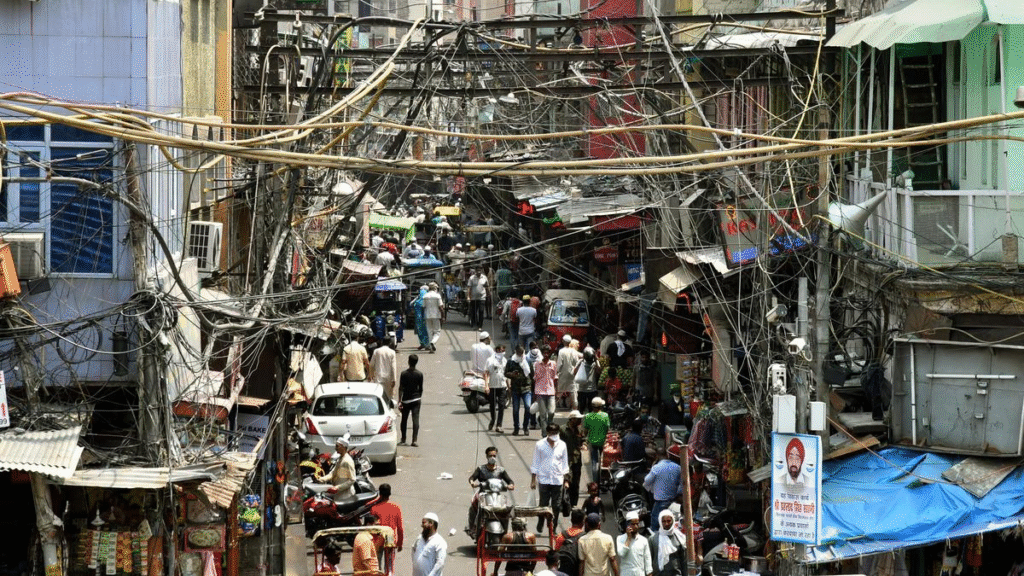Can you imagine Delhi without the web of tangled wires crisscrossing every pole and wall? For decades, these overhead cables have marred the beauty of India’s capital. But that visual pollution might soon be history. Delhi’s new Chief Minister Rekha Gupta has taken a historic step to launch the “Wire-Free Delhi” mission. Her bold promise: “Not a single wire will be visible in Delhi in the coming years.” This announcement isn’t just cosmetic, it represents a futuristic leap in Delhi’s urban planning.
- A Glimpse into the Action Plan
- Why Remove Overhead Wires?
- Who Will Execute the Project?
- What’s the Budget and Timeline?
- Full Delhi-wide implementation:
- How Will the Work Be Done?
- RWAs and local residents will be encouraged to:
- CM Rekha Gupta mentioned:
- How Will This Benefit Delhi?
- CM Rekha Gupta: Making Promises With Purpose
- Public Response: Relief or Resistance?
- A Global Outlook: Learning from Other Cities
- Challenges Ahead: Can This Really Be Done?
- What This Means for Delhi’s Future
- A Deeper Look: The Spiritual Cleanliness We Also Need
- FAQs to free Delhi from messy wire look
A Glimpse into the Action Plan
This wire-free mission is not a mere announcement. A systematic and layered approach has already been mapped out:
1. Ward-Level Audits: Identification of the most cluttered areas across wards.
2. Coordination with DISCOMS & Internet Providers: Private companies have been asked to cooperate or face penalties.
3. Underground Cabling: Safe underground wiring is planned in phases.
4. Heritage Zones First: Areas like Chandni Chowk, Connaught Place, and Karol Bagh will be transformed first.
Why Remove Overhead Wires?
Overhead wires in Delhi have long been a matter of concern. Not only are they an eyesore, but they also pose risks during storms, cause fire hazards, and hamper rescue operations in emergencies.

CM Rekha Gupta, in her announcement, stated:
“We want to make Delhi safe, organized, and beautiful. Not a single wire will be visible anymore.”
Who Will Execute the Project?
The project will be executed in coordination with:
- MCD (Municipal Corporation of Delhi)
- DISCOMS (Electricity providers like BSES & Tata Power)
- Telecom service providers
- PWD (Public Works Department)
The CM emphasized that all departments will work together, ensuring minimum disruption and timely execution.
What’s the Budget and Timeline?
While the exact figures are evolving, sources confirm that:
- The initial phase has been allotted ₹250 crore
- First targets: Chandni Chowk, Connaught Place, Karol Bagh, and major commercial zones
- Expected timeline for Phase 1: 9 to 12 months
Full Delhi-wide implementation:
Planned over the next 3 years
CM Gupta confirmed that the project is part of the broader “Delhi Beautification Mission 2025”.
How Will the Work Be Done?
The method involves:
- Laying underground ducts for electricity and telecom
- Removing dangerous and entangled poles
- Creating centralized cable boxes and updated junction points
- Maintaining fiber-optic standardization
- MCD and DISCOMS have already identified critical zones where overhead wires are dense and risky.
- Public and Resident Welfare Association Involvement
RWAs and local residents will be encouraged to:
- Report overhead wire hotspots
- Help ensure smooth coordination with technicians
- Monitor local execution timelines
CM Rekha Gupta mentioned:
“This is not just a government campaign; it’s a people’s movement.”
How Will This Benefit Delhi?
✔️ Improved urban safety during storms and monsoon
✔️ Clean, organized visual aesthetics
✔️ Fewer power outages & maintenance issues
✔️ Enhanced property value and tourism appeal
✔️ Encouragement of digital India goals via fiber-optic undergrounding
CM Rekha Gupta: Making Promises With Purpose
Since taking office, Rekha Gupta has been known for her bold and quick decisions. Her statement, “There will be no visual wires in Delhi. This city will shine again.”, is being seen as her strongest commitment to beautification and smart governance yet.

The campaign was flagged off from Karol Bagh, a congested zone filled with cable chaos. Gupta inspected the area herself and directed immediate action. Within days, hundreds of illegal wires were removed.
Public Response: Relief or Resistance?
The public reaction has been mixed but largely hopeful:
- Residents in old colonies see it as a relief from fire risks.
- Traders believe it will improve footfall and safety.
- Cable operators have voiced concerns about cost-sharing for underground cabling.
Still, the broader sentiment favors change. As one resident said, “Let Delhi finally look like a capital city, not a cable jungle.”
A Global Outlook: Learning from Other Cities
International cities like Paris, Singapore, and Tokyo have already embraced underground cabling for decades. Clean streets and aesthetic skylines help these cities draw in tourists and boost civic pride.
Delhi, too, aims to join that list. If implemented well, this mission could serve as a model for other Indian states.
Challenges Ahead: Can This Really Be Done?
While the dream is ambitious, the road ahead has its share of challenges:
- Budget constraints
- Resistance from private cable providers
- Coordination between multiple departments
But if strong leadership continues and policies stay consistent, the goal may be closer than ever.
What This Means for Delhi’s Future
CM Rekha Gupta’s ambitious initiative is more than just a civic facelift, it’s a step toward transforming Delhi into a world-class, safe, and visually clean capital. The removal of overhead wires doesn’t only benefit aesthetics but also boosts urban safety, promotes digital infrastructure (through underground cabling), and ensures smoother emergency responses.
Backed by coordinated planning, inter-departmental collaboration, and citizen involvement, this move has the potential to set a national benchmark. If executed effectively, it could redefine urban management for Indian metro cities.
A Deeper Look: The Spiritual Cleanliness We Also Need
While Delhi is being cleared of overhead wires, a more invisible “wiring” also needs attention, the mental and spiritual entanglements in our lives.
Just like cluttered streets disrupt the city’s beauty, ignorance, ego, and blind rituals clutter the mind and soul. In this modern era, true spiritual knowledge becomes essential for inner clarity and societal peace.
Sant Rampal Ji Maharaj has been delivering such transformative wisdom, clearing spiritual doubts with evidence-based truth from all holy scriptures.
To declutter your spiritual path, explore the authentic and universal spiritual knowledge at
FAQs to free Delhi from messy wire look
Q1: What is the aim of CM Rekha Gupta’s drive?
A: To make Delhi completely free of overhead wires and shift to underground cabling.
Q2: How will this be implemented?
A: Through phased operations starting in congested areas, in coordination with power companies and private operators.
Q3: Will this impact internet or electricity services?
A: Temporary disruptions may occur during the transition, but long-term services will become safer and more stable.
Q4: Who will bear the cost of this transformation?
A: It will be a joint responsibility between government departments and service providers.
Q5: Where can I learn more about inner spiritual transformation?
A: Visit www.SupremeGod.org to explore true knowledge shared by Sant Rampal Ji Maharaj Ji.









